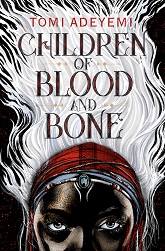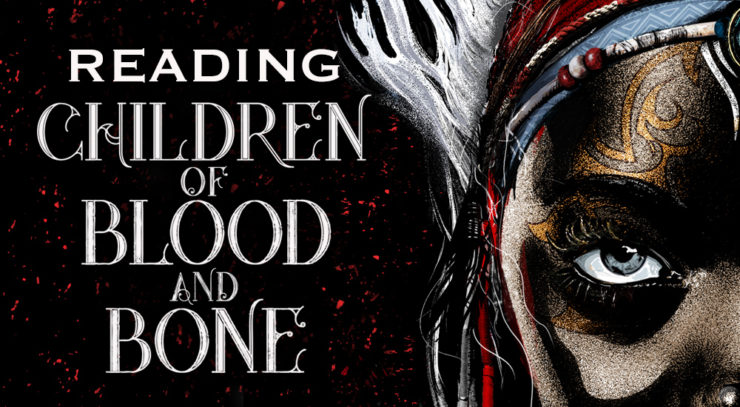Our reread of Children of Blood and Bone by Tomi Adeyemi continues this week with chapters 42-52, in which there’s another bloody battle where truces are forged, alliances tested, and ceasefires shattered.
Recap
When Amari wakes, she finds herself captured by rebels about her age. Kwame is hot-tempered and impulsive, a boy who focuses so intensely on the big picture that he’s lost sight of the small things that make the big picture worthwhile. Folake, the girl with the world’s most unfortunate nickname, has a calmer temperament. She’s a rule-follower who considers the consequences before she acts. While only 13, Zu is by far the most mature of the rebels, a trait that makes her a natural leader.
Using intel pried out of Jailin—who is now unconscious, thanks to Zèlie’s ruthless interrogation skills—Zèlie and Inan pick their way through the forest to the guerrilla encampment. He’s still unused to his magic and is unable to control it. Zèlie’s too busy being rash and grumpy to care. Inan cautions her against attacking the camp directly—he estimates over 50 rebels on the ground and hiding in the trees—so she gives herself a day to create an army of undead animations.
As they train, the tension between them expands until nothing else matters. Arguing drives their emotions, which in turn makes their magic stronger, but it’s a tenuous thing. They’ll fail as long as she values revenge over everything else and he refuses to acknowledge his complicity in his father’s oppressive system. Inan’s beginning to understand, but he has a long road ahead of him.
Back in the guerilla camp, Amari is having her own trust issues with maji. Zu sends Kwame to torture Tzain to get the truth. (They think Amari’s lying about her reason for having the scroll.) Amari realizes they must’ve survived the destruction of Warri after the guards retrieved the scroll for Saran. No wonder they don’t trust her.
Now a newly minted team, Inan and Zèlie attack the campsite. Amari uses the distraction to escape with a battered and bruised Tzain. Stuck with arrows, Zèlie falters in the face of a Burner, who gets ahold of the sunstone. Just as he’s about to strike, Zu stops him. She heals the trio—no, the quartet, now—and they listen to Zu recount what happened at Warri. The rebels agree to help them get to Zaria, and from there to the island.
Buy the Book


Children of Blood and Bone
But Tzain’s hatred of Inan is too great. He hates everything Inan stands for, so much so that he won’t trust the prince’s promise to “fix it with you.” He turns his anger onto his sister. The royal siblings fair better when they finally reunite. Hope is in the air between them.
Commentary
Zèlie hits the nail on the head: “Our lack of power and our oppression are one and the same, Inan. Without power we’re maggots. Without power the monarchy treats us like scum.” Inan responds: “Power is not the answer.” We’re getting into some thorny morality here. Both answers are correct. Zèlie knows the only way to undo Saran’s oppression is to restore the power of the maji. Yet Inan (and later Amari) understands that you can’t fix the system by simply swapping one dominant group for another. The maji can’t go back to being in power anymore than the kosidán can remain in power. There must be equity. Trouble is, Inan can’t see that the people in control can’t be the ones in charge of dismantling the old system and building the new one.
I love that, as Zèlie evolves from divîner to maji, her hair becomes curly. I’m not one to wag my finger at Black women for straightening their hair—hair is a complicated enough subject in our culture without adding shame to the mix—but it is a trend rooted in some unpleasant history. In ye olden days, Black hair was always naturally curly and white people saddled us with the term “nappy,” as if tightly coiled hair was somehow inferior to or worse than straight hair. (South Africa would take this to the extreme with the apartheid-era pencil test.)
When hair straighteners and relaxers were developed in the late 19th and early 20th century, the desire for “good hair” drove millions to purchase relaxers, hot combs, and flat irons. Women like Annie Malone and Madam C. J. Walker became millionaires selling hair care products, relaxers, and straighteners to Black women across America. The shift back to natural hair came with the Civil Rights Movement and the rekindled appreciation for African traditions. The Afro was the antithesis of “good hair”—it was a big and bold celebration of natural Black hair.
With that context in mind, Zèlie’s ever tightening curls are a sign of how her body is not only responding to her increasing magical powers, but also how she’s growing into her true self. There’s nothing inherently wrong with straight hair, but in Zèlie’s case it represents her forced adherence to the dominant culture. Like her white hair, her new curls mark her as different from the kosidán—not in a way that is better or worse, just different. Saran has denied Zèlie access to her culture through civil, legal, and social oppression, but now she’s fighting back. She likes her curls (and probably can’t wait to go back to being as tightly coiled as she was before the Raid) because they represent the truest form of her lost culture.
There’s one thing that troubles me about Zèlie and Inan’s interactions: how Inan’s education is dependent upon her pain. In the real world, we see this in how so many books, television shows, and movies about African Americans—particularly those written by white authors for primarily white audiences—revolve around exposing and exploiting Black pain. Racism, lynchings, police brutality, and bigotry become tools for white learning. Our past is stripped from our bodies and given to white people in order to “open their eyes” and teach them empathy.
My history and culture is mine. Others are welcome to look and learn, but my ancestors are not theirs to take or touch or teach with. Inan doesn’t need Zèlie’s horrific memories to understand oppression. He has a whole frakking kingdom of examples and histories to examine. He can open his own damn eyes.
And that about does it for this week. I kinda wish Tomi Adeyemi would write a novella about the child maji army and what happened in the month after the attack on Warri. I’m still super interested in them and their story.
Be back here next week as we continue our reread with chapters 53-60.
Alex Brown is a high school librarian by day, local historian by night, author and writer by passion, and an ace/aro Black woman all the time. Keep up with her every move on Twitter and Insta, or follow along with her reading adventures on her blog.










